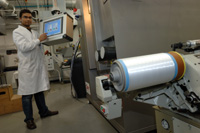
Imagine a world where all those gadgets that seem to constantly need recharging – from your mobile phone to your laptop to your mp3 – can just charge themselves.
Research scientists from the University of Bolton’s Institute for Materials Research and Innovation (IMRI) claim that world is very close and they are now working with a development company in China to bring their latest smart material invention to market.
With funding from the Knowledge Centre for Materials Chemistry (KCMC), the IMRI scientists have now created a unique product – a flexible piezoelectric fibre that can be woven to create natural energy-harnessing fabrics. Energy is created as the material is moved.
But now the researchers have added to it, patenting a method for creating a photovoltaic- piezoelectric fibre which would also harness the power of the sun, meaning the material could be a solar energy source as well.
Principal inventor of the hybrid fibre is Director of Research at the University, Professor Elias Siores. He said: ‘There is nothing like our hybrid piezoelectric and photovoltaic fibre in the market at present. Scientists in America have created piezoelectric fibres with limited flexibility and consequently limited applications.
‘As experts in smart materials research and development, we believe that we could build on these ideas, developing flexible smart structures that could generate energy from movement but are also durable and flexible.
‘We have already developed a flexible fibre that generates electricity from movement created by wind and rain, but we also wanted to incorporate solar capabilities as well, creating a hybrid material.
‘Our hybrid photovoltaic-piezoelectric material has so much potential that it can be woven into everything, including laptop and mobile phone cases. In its casing the appliance could be charging, as it is handled or placed near sunlight. At home, a tree with needle like fibres, like a pine tree, could be converting sun, wind and rain into electrical energy which is stored ready for charging.
‘The most immediate applications will be in the area of low-power microelectronic-driven devices like mobiles, laptops, MP3s, Ipads – anything that requires re-chargeable batteries or small batteries to run.
‘Obviously you wouldn’t leave your laptop out in the wind and the rain but movement created by being carried in its case or being placed near a window could be enough to generate the energy to recharge it.
‘The next challenge will then be to improve on the power conversion through on-going research and development so it can feed more power-hungry systems.’
The research team is set to start producing samples of the hybrid material using equipment bought through £1 million funding from KCMC.
The team will then begin thoroughly testing the material’s effectiveness in gathering wind, rain and solar energy. They will also be carrying out tests for its effectiveness in generating electricity from wave movement, under the ocean.
Said Professor Siores: ‘Just as a jellyfish’s tendrils move with the motion of waves, so could structures produced from this material, collecting energy from the sea . We’re also looking at its potential in space as well.’
Research Fellow Dr Ravi Hadimani has been measuring how much electricity is generated by the hybrid material. Said Dr Hadimani: ‘We have conducted a number of experiments, measuring lower-level electricity generated by hybrid photovoltaic and piezoelectric cell but can bring in one watt of energy per 20cm x20cm square of the material. The advantage of a hybrid photovoltaic and piezoelectric cell is that it can generate energy when there is no sunlight on a rainy or windy day, by using wind and rain energy. When you consider a low-energy light bulb uses nine watts you can see that now, even in its early development stages, the material is producing credible power.
‘We will be testing the photovoltaic- piezoelectric fibre as soon as we can. But in theory it should be at least as effective in gathering energy.’
The University of Bolton will be working with GK opto-electronics Co Ltd and Nanchang Hangkong University in China to further develop the energy-harnessing fibre over the next three years.



